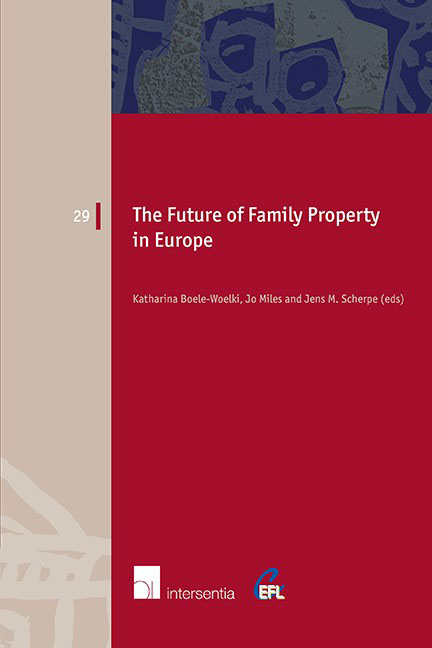Book contents
- Frontmatter
- Preface
- Contents
- List of authors
- PART ONE KEYNOTE LECTURE
- PART TWO MATRIMONIAL PROPERTY LAW IN EU ROPE
- PART THREE FAMILY CONTRACTS – ISSUES OF AUTONOMY
- PART FOUR PROTECTION OF OLDER PEOPLE IN LAW
- PART FIVE FREEDOM OF TESTATION AND PROTECTION OF FAMILY MEMBERS
- PART SIX CHILD MAINTENANCE
- PART SEVEN UNIFICATION OF PRIVATE INTERNATIONAL FAMILY LAW
- PART EIGHT CLOSING REMARKS
The Unification of Private International Law in Europe: A Success Story?
Published online by Cambridge University Press: 08 May 2020
- Frontmatter
- Preface
- Contents
- List of authors
- PART ONE KEYNOTE LECTURE
- PART TWO MATRIMONIAL PROPERTY LAW IN EU ROPE
- PART THREE FAMILY CONTRACTS – ISSUES OF AUTONOMY
- PART FOUR PROTECTION OF OLDER PEOPLE IN LAW
- PART FIVE FREEDOM OF TESTATION AND PROTECTION OF FAMILY MEMBERS
- PART SIX CHILD MAINTENANCE
- PART SEVEN UNIFICATION OF PRIVATE INTERNATIONAL FAMILY LAW
- PART EIGHT CLOSING REMARKS
Summary
INTRODUCTION
If an outside observer were to look at the development of private international law in Europe during the last decade he or she would certainly be amazed at the amount of new Community legislation that has either already been passed or is currently being prepared. But not only would the sheer number of new rules catch his or her attention but also the speed of such development, which only started ten years ago when the Treaty of Amsterdam entered into force and the European Community gained competence to legislate in this area of the law. The landscape of the unification of private international law in Europe has completely changed. Gone are the old days when after lengthy preparation the Hague Conference produced one instrument every four years and this instrument was carefully scrutinized and discussed before it eventually came into force! Instead there is hustle and bustle everywhere!
This is even the case in the area of family and succession law where Community involvement came somewhat as a surprise. The Brussels II bis Regulation on the dissolution of marriage and parental responsibility has been applicable since March 2005 and is already a substitute for Regulation 1347/2000. It contains rules on jurisdiction, cooperation between authorities and the recognition and enforcement of decisions in the areas of divorce, separation and marriage annulment, as well as on parental responsibility. A new Maintenance Regulation was adopted in 2009. When it comes into force it will replace the rules on jurisdiction, recognition and enforcement of the Brussels I Regulation, and will also provide a new cooperation regime between the authorities of the different Member States. A Proposal for a new Regulation on Succession is currently being discussed in Brussels. Two new Proposals authorizing and implementing enhanced cooperation in the area of the law applicable to divorce and legal separation were made public at the end of March 2010. The Council decision authorizing enhanced cooperation in this area was subsequently very quickly adopted on 12th July 2010. On 20th December 2010 Council Regulation 1259/2010 was finally approved. A working party is preparing a proposal for a Regulation on matrimonial property, which should be ready during the second semester of 2010. The European Union can certainly not be blamed for not being productive.
- Type
- Chapter
- Information
- The Future of Family Property in Europe , pp. 329 - 340Publisher: IntersentiaPrint publication year: 2011
- 1
- Cited by

